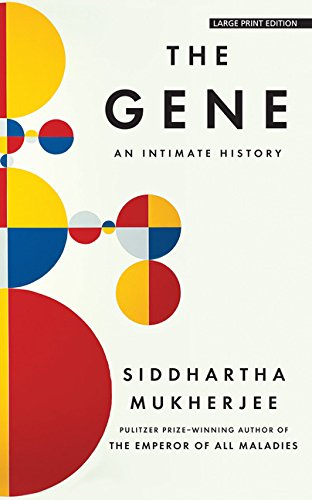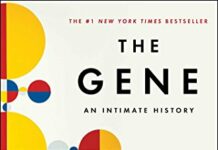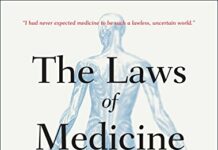
Ebook Info
- Published: 2017
- Number of pages: 879 pages
- Format: Epub
- File Size: 3.84 MB
- Authors: Siddhartha Mukherjee
Description
From the Pulitzer Prize-winning, bestselling author of The Emperor of All Maladies–a magnificent history of the gene and a response to the defining question of the future: What becomes of being human when we learn to “read” and “write” our own genetic information?
Siddhartha Mukherjee has a written a biography of the gene as deft, brilliant, and illuminating as his extraordinarily successful biography of cancer. Weaving science, social history, and personal narrative to tell us the story of one of the most important conceptual breakthroughs of modern times, Mukherjee animates the quest to understand human heredity and its surprising influence on our lives, personalities, identities, fates, and choices.
Throughout the narrative, the story of Mukherjee’s own family–with its tragic and bewildering history of mental illness–cuts like a bright, red line, reminding us of the many questions that hang over our ability to translate the science of genetics from the laboratory to the real world. In superb prose and with an instinct for the dramatic scene, he describes the centuries of research and experimentation–from Aristotle and Pythagoras to Mendel and Darwin, from Boveri and Morgan to Crick, Watson and Franklin, all the way through the revolutionary twenty-first century innovators who mapped the human genome.
As The New Yorker said of The Emperor of All Maladies, “It’s hard to think of many books for a general audience that have rendered any area of modern science and technology with such intelligence, accessibility, and compassion…An extraordinary achievement.” Riveting, revelatory, and magisterial history of a scientific idea coming to life, and an essential preparation for the moral complexity introduced by our ability to create or “write” the human genome, The Gene is a must-read for everyone concerned about the definition and future of humanity. This is the most crucial science of our time, intimately explained by a master.
User’s Reviews
Siddhartha Mukherjee is a cancer physician and researcher. He is an assistant professor of medicine at Columbia University and a staff cancer physician at the CU/NYU Presbytarian Hospital. A former Rhodes scholar, he graduated from Stanford University, University of Oxford (where he received a PhD studying cancer-causing viruses) and from Harvard Medical School. His laboratory focuses on discovering new cancer drugs using innovative biological methods. Mukherjee trained in cancer medicine at the Dana Farber Cancer Institute of Harvard Medical School and was on the staff at the Massachusetts General Hospital. He has published articles and commentary in such journals as Nature, New England Journal of Medicine, Neuron and the Journal of Clinical Investigation and in publications such as the New York Times and the New Republic. His work was nominated for Best American Science Writing, 2000 (edited by James Gleick). He lives in Boston and New York with his wife, Sarah Sze, an artist, and with his daughter, Leela.
Reviews from Amazon users, collected at the time the book is getting published on UniedVRG. It can be related to shiping or paper quality instead of the book content:
⭐ If you are thinking of buying this book, please note the word “History” in the title. If you are looking for a history book on genetics, heritability and the human understanding of these things, this is a great book. If you are interested in deep technical descriptions or in understanding the latest in gene editing technology, this is not the right book.The great aspect of the book is that it weaves together and conceptualizes all the bits of genetics we remember from high school biology and various articles and books we have read over the decades. The author is very good at this. The book can give you an excellent basic understanding of the topic.The downsides: 1. The author attempts to weave personal family stories into the book and relate them to genetics. The stories are not interesting and are not tied into the narrative well. Fortunately, it is very easy to skip these sections. You lose nothing in your understanding if you just skip them. 2. Every time a sensitive topic comes up like eugenics, the author puts in a great deal of effort in virtue signaling about being on the right side of the topic. The endless condemning of Nazis is not really necessary. We kind of assume the author is not an admirer of Nazis. The author goes into a long straw man argument attempting to debunk “The Bell Curve” and then restates the primary thesis of the book as established fact. It looked like he had never read the book, but needed to condemn it so he could stay in academic good graces. 3. The later parts of the book fall short as the author gets into very recent technology. The early historical narratives are excellent. The later chapters lack quality and clarity.All in all, a very worthwhile book and I have not seen anything that would provide a better history. Read the book, just be aware that there are flaws.
⭐ This is an interesting book. Indeed, it is a fascinating book. However, it suffers from a very basic flow. The author is attempting to write a Politically Correct (PC) book about the least PC subject imaginable, genetics. The book opens with a harrowing tale of how genetics (genetic inheritance) has cursed the author’s family (via an inherited tendency towards schizophrenia). This sad tale was quite illuminating for me personally. My own family does not have a history of schizophrenia. However, the book mentions three other very serious inherited (as in the tendency towards) disorders that do run in my family.Somehow, the reader is expected to believe that a great many aspects of human life are heritable (to a greater or lesser extent), but anything PC is not. To be fair that is not really the author’s position (in all cases). The dominant view of sexual preference (homosexuality) is that it is at least partially genetic. The gay community and the author embrace at least partial genetic determinism in this case (sexual preference) and the evidence supporting this view is quite strong. Of course, in this case, genetic determinism (partial) and PC are aligned making the author’s take rather easy. In this context the author mocks (quite rightfully) the opinions of Lewontin.“There is no acceptable evidence that homosexuality has any genetic basis. . . . The story has been manufactured out of whole cloth,” Lewontin wrote.The author also argues that sex is real and sex and gender are inseparable in most (but not all cases). The tragic tale of David Reimer shows up, along with a (highly justified) denunciation of the abominable Dr. John Money. Quote from the book“These case reports finally put to rest the assumption, still unshakably prevalent in some circles, that gender identity can be created or programmed entirely, or even substantially, by training, suggestion, behavioral enforcement, social performance, or cultural interventions. It is now clear that genes are vastly more influential than virtually any other force in shaping sex identity and gender identity”The author also argues that race is real and has a genetic basis. This is the scientific consensus, even if the “non-existence of race” is the rigidly enforced PC dogma of our time. Conversely, the author argues that “race is only skin deep”. This may or may not be true. Quote“Yet, even a young species possesses history. One of the most penetrating powers of genomics is its ability to organize even closely related genomes into classes and subclasses. If we go hunting for discriminatory features and clusters, then we will, indeed, find features and clusters to discriminate. Examined carefully, the variations in the human genome will cluster in geographic regions and continents, and along traditional boundaries of race. Every genome bears the mark of its ancestry. By studying the genetic characteristics of an individual you can pinpoint his or her origin to a certain continent, nationality, state, or even a tribe with remarkable accuracy. It is, to be sure, an apotheosis of small differences—but if this is what we mean by “race,” then the concept has not just survived the genomic era, it has been amplified by it.”The author invokes Lewontin to defend his ideas about genetics and race. Of course, this is the same Lewontin whom the author mocks with respect to homosexuality.The author goes to some pains to denounce eugenics, Nazi and otherwise. Reading the book, you would never know that the most prominent advocates of eugenics (in the UK and perhaps the US) were left-wing socialists. For example, Sidney Webb was a prominent far-left political figure who devoted much of his later life to promoting the Soviet Union. The list of left-wing eugenicists is rather long and includes George Bernard Shaw, William Beveridge, Marie Stopes (the UK version of Margaret Sanger who was also a eugenicist), Harold Laski, Haldane (a Marxist), and of course, John Maynard Keynes (not a Marxist).To the author’s credit, the modern revival of eugenics (via prenatal testing and selective abortion) is covered in detail, with the troubling echoes of the past heard well. A more subtle point (unmentioned by the author) is that institutionalized populations are (these days) deliberately isolated to prevent sexual relationships. In a bygone era, the “unfit” were sterilized, now that kept behind walls and barbed wire.
⭐ Genetics is humanity and life writ large, and this book on the gene by physician and writer Siddhartha Mukherjee paints on a canvas as large as life itself. It deals with both the history of genetics and its applications in health and disease. It shows us that studying the gene not only holds the potential to transform the treatment of human disease and to feed the world’s burgeoning population, but promises to provide a window into life’s deepest secrets and into our very identity as human beings.The volume benefits from Mukherjee’s elegant literary style, novelist’s eye for character sketches and expansive feel for human history. While there is ample explanation of the science, the focus is really on the brilliant human beings who made it all possible. The author’s own troubling family history of mental illness serves as a backdrop and keeps on rearing its head like a looming, unresolved question. The story begins with a trip to an asylum to see his troubled cousin; two of his uncles have also suffered from various “unravelings of the mind”. This burden of personal inheritance sets the stage for many of the questions about nature, nurture and destiny asked in the pages that follow.The book can roughly be divided into two parts. The first part is a sweeping and vivid history of genetics. The second half is a meditation on what studying the gene means for human biology and medicine.The account is more or less chronological and this approach naturally serves the historical portion well. Mukherjee does a commendable job shedding light on the signal historical achievements of the men and women who deciphered the secret of life. Kicking off from the Greeks’ nebulous but intriguing ideas on heredity, the book settles on the genetics pioneer Gregor Mendel. Mendel was an abbot in a little known town in Central Europe whose pioneering experiments on pea plants provided the first window into the gene and evolution. He discovered that discrete traits could be transmitted in statistically predictable ways from one generation to next. Darwin came tantalizingly close to discovering Mendel’s ideas (the two were contemporaries), but inheritance was one of the few things he got wrong. Instead, a triumvirate of scientists rediscovered Mendel’s work almost thirty years after his death and spread the word far and wide. Mendel’s work shows us that genius can emerge from the most unlikely quarters; one wonders how rapidly his work might have been disseminated had the Internet been around.The baton of the gene was next picked up by Francis Galton, Darwin’s cousin. Galton was the father of eugenics. Eugenics has now acquired a bad reputation, but Galton was a polymath who made important contributions to science by introducing statistics and measurements in the study of genetic differences. Many of the early eugenicists subscribed to the racial theories that were common in those days; many of them were well intended if patronizing, seeking to ‘improve the weak’, but they did not see the ominous slippery slope which they were on. Sadly their ideas fed into the unfortunate history of eugenics in America and Europe. Eugenics was enthusiastically supported in the United States; Mukherjee discusses the infamous Supreme Court case in which Oliver Wendell Holmes sanctioned the forced sterilization of an unfortunate woman named Carrie Buck by proclaiming, “Three generations of imbeciles are enough”. Another misuse of genetics was by Trofim Lysenko who tried to use Lamarck’s theories of acquired characteristics in doomed agricultural campaigns in Stalinist Russia; as an absurd example, he tried to “re educate” wheat using “shock therapy”. The horrific racial depredations of the Nazis which the narrative documents in some detail of course “put the ultimate mark of shame” on eugenics.The book then moves on to Thomas Hunt Morgan’s very important experiments on fruit flies. Morgan and his colleagues found a potent tool to study gene propagation in naturally occurring mutations. Mutations in specific genes (for instance ones causing changes in eye color) allowed them to track the flow of genetic material through several generations. Not only did they make the crucial discovery that genes lie on chromosomes, but they also discovered that genes could be inherited (and also segregated) in groups rather than by themselves. Mukherjee also has an eye for historical detail; for example, right at the time that Morgan was experimenting on flies, Russia was experimenting with a bloody revolution. This coincidence gives Mukherjee an opening to discuss hemophilia in the Russian royal family – a genetically inherited disease. A parallel discussion talks about the fusion of Darwin’s and Mendel’s ideas by Ronald Fisher, Theodosius Dobzhansky and others into a modern theory of genetics supported by statistical reasoning in the 40s – what’s called the Modern Synthesis.Morgan and others’ work paved the way to recognizing that the gene is not just some abstract, ether-like ghost which transmits itself into the next generation but a material entity. That material entity was called DNA. The scientists most important for recognizing this fact were Frederick Griffiths and Oswald Avery and Mukherjee tells their story well; however I would have appreciated a fuller account of Friedrich Miescher who discovered DNA in pus bandages from soldiers. Griffiths showed that DNA can be responsible for converting non-virulent bacteria to virulent ones; Avery showed that it is a distinct molecule separate from protein (a lot of people believed that proteins with their functional significance were the hereditary material).All these events set the stage for the golden age of molecular biology, the deciphering of the structure of DNA by James Watson (to whom the quote in the title is attributed), Francis Crick, Rosalind Franklin and others. Many of these pioneers were inspired by a little book by physicist Erwin Schrodinger which argued that the gene could be understood using precise principles of physics and chemistry; his arguments turned biology into a reductionist science. Mukherjee’s account of this seminal discovery is crisp and vivid. He documents Franklin’s struggles and unfair treatment as well as Watson and Crick’s do-what-it-takes attitude to use all possible information to crack the DNA puzzle. As a woman in a man’s establishment Franklin was in turn patronized and sidelined, but unlike Watson and Crick she was averse to building models and applying the principles of chemistry to the problem, two traits that were key to the duo’s success.The structure of DNA of course inaugurated one of the most sparkling periods in the history of intellectual thought since it immediately suggested an exact mechanism for copying the hereditary material as well as a link between DNA and proteins which are the workhorses of life. The major thread following from DNA to protein was the cracking of the genetic code which specifies a correspondence between nucleotides on a gene and the amino acids of a protein: the guiding philosophers in this effort were Francis Crick and Sydney Brenner. A parallel thread follows the crucial work of the French biologists Francois Jacob and Jacques Monod – both of whom had fought in the French resistance during World War 2 – in establishing the mechanism of gene regulation. All these developments laid the foundation for our modern era of genetic engineering.The book devotes a great deal of space to this foundation and does so with verve and authority. It talks about early efforts to sequence the gene at Harvard and Cambridge and describes the founding of Genentech, the first company to exploit the new technology which pioneered many uses of genes for producing drugs and hormones: much of this important work was done with phages, viruses which infect bacteria. There is also an important foray into using genetics to understand embryology and human development, a topic with ponderous implications for our future. With the new technology also came new moral issues, as exemplified by the 1975 Asilomar conference which tried to hammer out agreements for the responsible use of genetic engineering. I am glad Mukherjee emphasizes these events, since their importance is only going to grow as genetic technology becomes more widespread and accessible.These early efforts exploded on to the stage when the Human Genome Project (HGP) was announced, and that’s where the first part of the book roughly ends. Beginning with the HGP, the second part mainly focuses on the medical history and implications of the gene. Mukherjee’s discussion of the HGP focuses mainly on the rivalries between the scientists and the competing efforts led by Francis Collins of the NIH and Craig Venter, the maverick scientist who broke off and started his own company. This discussion is somewhat brief but it culminates in the announcement of the map of the human genome at the White House in 2000. It is clear now that this “map” was no more than a listing of components; we still have to understand what the components mean. Part of that lake of ignorance was revealed by the discovery of so-called ‘epigenetic’ elements that modify not the basic sequence of DNA but the way it’s expressed. Epigenetics is an as yet ill-understood mix of gene and environment which the book describes in some detail. It’s worth noting that Mukherjee’s discussion of epigenetics has faced some criticism lately, especially based on his article on the topic in the New Yorker.The book then talks about early successes in correlating genes with illness that came with the advent of the human genome and epigenome; genetics has been very useful in finding determinants and drugs for diseases like sickle cell anemia, childhood leukemia, breast cancer and cystic fibrosis. Mukherjee especially has an excellent account of Nancy Wexler, the discoverer of the gene causing Huntington’s disease, whose search for its origins led her to families stricken with the malady in remote parts of Venezuela. While such diseases have clear genetic determinants, as Mukherjee expounds upon at length, genetic causes for diseases like cancer, diabetes and especially the mental illness which plagues members of the author’s family are woefully ill-understood, largely because they are multifactorial and suffer from weakly correlated markers. We have a long way to go before the majority of human diseases can be treated using gene-based treatment. In its latter half the book also describes attempts to link genes to homosexuality, race, IQ, temperament and gender identity. The basic verdict is that while there is undoubtedly a genetic component to all these factors, the complex interplay between genes and environment means that it’s very difficult currently to tease apart influences from the two. More research is clearly needed.The last part of the book focuses on some cutting edge research on genetics that’s uncovering both potent tools for precise gene engineering as well as deep insights into human evolution. A notable section of the book is devoted to the recent discovery that Neanderthals and humans most likely interbred. Transgenic organisms, stem cells and gene therapy also get a healthy review, and the author talks about successes and failures in these areas (an account of a gene therapy trial gone wrong is poignant and rattling) as well as ethical and political questions which they raise. Finally, a new technology called CRISPR which has taken the world of science by storm gets an honorary mention: by promising to edit and propagate genes with unprecedented precision – even in the germ line – CRISPR has resurrected all the angels and demons from the history of genetics. What we decide about technologies like CRISPR today will impact what our children do tomorrow. The clock is ticking.In a project as ambitious as this there are bound to be a few gaps. Some of the gaps left me a bit befuddled though. There are a few minor scientific infelicities: for instance Linus Pauling’s structure of DNA was not really flawed because of a lack of magnesium ions but mainly because it sported a form of the phosphate groups that wouldn’t exist at the marginally alkaline pH of the human body. The book’s treatment of the genetic code leaves out some key exciting moments, such as when a scientific bombshell from biochemist Marshall Nirenberg disrupted a major meeting in the former Soviet Union. I also kept wondering how any discussion of DNA’s history could omit the famous Meselson-Stahl experiment; this experiment which very elegantly illuminated the central feature of DNA replication has been called “the most beautiful experiment in biology”. Similarly I could see no mention of Barbara McClintock whose experiments on ‘jumping genes’ were critical in understanding how genes can be turned on and off. I was also surprised to find few details on a technique called PCR without which modern genetic research would be virtually impossible: both PCR and its inventor Kary Mullis have a colorful history that would have been worth including. Similarly, details of cutting-edge sequencing techniques which have outpaced Moore’s Law are also largely omitted. I understand that a 600 page history cannot include every single scientific detail, but some of these omissions seem to me to be too important to be left out.More broadly, there is no discussion of the pros and cons of using DNA to convict criminals: that would have made for a compelling human interest story. Nor is there much exploration of using gene sequences to illuminate the ‘tree of life’ which Darwin tantalizingly pulled the veil back on: in general I would have appreciated a bigger discussion of how DNA connects us to all living creatures. There are likewise no accounts of some of the fascinating applications of DNA in archaeological investigations. Finally, and this is not his fault, the author suffers from the natural disadvantage of not being able to interview many of the pioneers of molecular biology since they aren’t around any more (fortunately, Horace Freeland Judson’s superb “The Eighth Day of Creation” fills this gap: Judson got to interview almost every one of them for his book). This makes his account of science sound a bit more linear than the messy, human process that it is.The volume ends by contemplating some philosophical questions: What are the moral and societal implications of being able to engineer genomes even in the fetal stage? How do we control the evils to which genetic technology can be put? What is natural and what isn’t in the age of the artificial gene? How do we balance the relentless, almost inevitable pace of science with the human quest for responsible conduct, dignity and equality? Mukherjee leaves us with a picture of these questions as well as one of his family and their shared burden of mental illness: a mirage searching for realization, a sea of questions looking for a tiny boat filled with answers.Overall I found “The Gene: An Intimate History” to be beautifully written with a literary flair, and in spite of the omissions, the parts of genetic history and medicine which it does discuss are important and instructive. Its human stories are poignant, its lessons for the future pregnant with pitfalls and possibilities. Its sweeping profile of life’s innermost secrets could not help but remind me of a Japanese proverb quoted by physicist Richard Feynman: “To every man is given the key to the gates of heaven. The same key opens the gates of hell.” The gene is the ultimate key of this kind, and Mukherjee’s book explores its fine contours in all their glory and tragedy. We have a choice in deciding which of these contours we want to follow.
⭐ I really liked Emperor of maladies, but this one was boring and I read only half of it. There isnt much to say about gene but the author didnt want to keep the book concise. So you’ll find detailed descriptions of conference halls, office rooms etc and interspersed with personal stories which have nothing with the book. It is becoming a new trend among authors to get some sympathy by saying some sad family story (related or not). In all it gives decent overview of the events that led to discovery of gene. Also a lot of things get very technical but the author doesnt believe in using diagrams. But a picture is worth a thousand words. We will very technical descriptions of cell spliting and stuff with no figures or charts. That made it tough for me to keep up with the book.
⭐ The author of ‘The Emperor of Maladies: A Biography of Cancer’ has written another terrific book. You do not have to be adept at science or strutting around with an Einstein intelligence to understand and appreciate Dr. Mukherjee’s ‘The Gene: An Intimate History.’ Some portions I needed to read at a slower rate to fully understand his explanation, but they were worth the effort. A few times this humble dimwit even went to YouTube for visual clarification. If you do not understand all the commotion about the gene, then this book will surely enlighten you.While it is not the center of his presentation religious orthodoxy was a hindrance for centuries in trying to understand how heredity works. Hypotheses led to experimentation and observation but public reaction, even within academic circles, was met with heated resistance because the evidence challenged the concept that God or gods created the world as we see it. Evolution was peeing all over their fairy tales. Dr. Mukherjee covers the first notable hypotheses as far back as the Greek Empire as well as Charles Darwin’s and Gregor Mendel’s history and contributions to the theory of evolution and heredity. The book continues down the roads of discovery to explain how legions of scientists deciphered the existence and function of genes. ‘The Gene’ covers such topics as eugenics; mutations a.k.a. genetic variation; DNA and RNA; the Human Genome Project; dominant and recessive genes; the importance of proteins; gene cloning; fetal diagnosis; and creating medicines. Illnesses such as Huntington’s disease, hemophilia, Down’s Syndrome, cystic fibrosis, cancers, and mental illness are explained through the personal struggles by various victims. You’re seriously one cold fish if you do not find their stories heart-wrenching. Dr. Mukherjee includes personal stories about his extended family coping with multiple cases of schizophrenia. While the first half of the book is more a history of gene discovery and science, the last portion takes a more theoretical approach by addressing complex science and moral issues such as what constitutes intelligence; sex determinism; gender identity; sexual identity; the effects of genes on human personalities and behavior; embryonic stem cell research; gene editing, and the potential hazards of the genetic-commercial complex. The author includes some graphics at key points to help the reader understand the gene’s nature and has eight color pages of photos.Dr. Mukherjee truly has a gift in taking complex issues and describing them in a clear entertaining fashion as well as presenting its impact on a human level. My emotions fluctuated between hopefulness at healing the afflicted and serious concern that some myopic bozo or bozos are eventually going to accidentally unleash some new horror. Any individual who has a curious mind and is not squeamish about information that might challenge their preconceived notions of how nature works will likely enjoy ‘The Gene’ and become a more enlightened individual. Like it or not, the gene is out of the bottle and there’s no going back. Cross your fingers.
⭐ If you are interested in genetics, but really haven’t got much of a background in the science, this is the book for you. Mukherjee begins the story relating his own family experience and the effects of a particular genetic condition which dramatically changes the lives of those afflicted by it. As a sensitive and observant child, he develops an abiding interest in just what this is which has so destroyed the characters of those he loved. I thought I had settled in for a family saga but the story flips to a history of genetics, which is presented in such a fascinating way that I was keen to get back to it – which after all, is the benchmark of any good book. Mukerjee’s family history is not forgotten, however. We revisit it as we learn a little more about genetics generally and this serves to keep the story relevant and human.Mind you, having just re-read the paragraph above, I have to say that even if you DO have a background in science, you will still find this book riveting in the way in holds your attention while taking us on the amazing journey which is the story of all of us. The title, “The Gene: an intimate history” says it all. We are intimately connected, not just with Mukerjee and his family but with all other humans.
⭐ I read with great interest Siddhartha Mukherjee’s recent book The Gene: An Intimate History. This work represents a masterful weaving together, intimately, of many different strands related to the gene. First and foremost is the technical strand. Here Mukherjee goes into detail, explaining in simple language many key concepts behind genes. What I most liked was the discussion of the Mitochondrial Eve and the dating of populations in terms of coalescent theory and the overview of apoptosis and master regulators and how the careful tracing of cell lineages gave rise to the unintuitive idea of cell death. I also liked the account of the development of positional cloning as just a mental lightning bolt relating to what random markers on the genome connect to.The next thread, of course, is the scientists themselves. Here we see them feuding and competing with each other. There is, of course, the famous tale of Watson and Crick versus Rosalind Franklin and how the former dynamic duo essentially stole the key concepts in “Photograph 51” from her. Then there are discussions of the rivalries of Morgan’s disciples, in particular Muller and Sturtevant, and the rivalry at the beginning of biotechnology between Boyer and Swanson in California versus Gilbert on the East Coast, racing to clone insulin and other genes.A third strand relates to the ethical and social implications of genetics. Unfortunately the field has had quite a checkered past with eugenics beginning almost as soon as genetics. The book describes how eugenics, in a sense, set the backdrop for Nazism and the horrors of the Second World War. What is interesting is the contrast of the Nazi focus on genetic determinism with the Soviet notion, backed by their scientist Lysenko, which is diametrically opposite, that an organism could be profoundly changed by its environment. The book then goes on to discuss how we are coming into a new era of eugenics, dubbed new-genics, based on positive choice, in terms of having the genetic offspring of one’s choosing.The final strand of the book is in a sense the most intimate: the author often digresses on his own personal history in connection to genetics, discussing in particular his family battles with schizophrenia. It is sometimes hard to see how these anecdotes relate to the science, but they do add to readability.Overall the readability of this book is fantastic. On the one hand, it has lots of simple aphorisms that stick in one’s head. One that comes to my mind most is how Mukherjee concisely characterized the key elements of 20th Century science as the byte, the atom and the gene, putting those three concepts together in a simple phrase. Another great illustration of the book’s readability is how the author contrasts the biochemist versus the geneticist, with the first focusing on concentrating something more and the second looking for informative differences to pick something out of the crowd.Overall I would highly recommend this book as it is a great way to soak up a lot of scientific knowledge while being exposed to other dimensions of genetics.
⭐ Interest in the power of the gene has heightened by the popularity of the numerous ancestry testing sites, like 23 & Me, which is the one I used to find out that I was 99% “Northwestern” European, which included Britain and Ireland (this would also include Scotland, which wasn’t a surprise) but the “Irish” ancestry was. The book provides a comprehensive history of the most intimate science of our time—the fundamentals of heredity. What better person to tell this story than the author of The Laws of Medicine and The Emperor of All Maladies: A Biography of Cancer, which won the 2011 Pulitzer Prize for General Nonfiction and was voted one of Time’s 100 best and most influential books since 1923. Mukherjee is a Rhodes Scholar, a graduate of Stanford University and the University of Oxford, not to mention Harvard Medical School.The author has embarked on a most ambitious quest to understand human heredity’s influence on lives, personalities, identities, fates and the choices we make as individuals. Through the story, the author’s own family members were present, plagued by mental illness. The book is divided into two parts. A vivid history of the development of genetics and then a meditation of the study of what it means for biology and medicine (not to mention human identity). He also explores the challenges and dangers of genetic modification.For years, “experts” proposed that male homosexuality was caused by the distorted dynamics of a family, “by the fatal combination of a smothering mother who was often ‘close-binding’ and (sexually) intimate, if not overtly seductive, to her son and by a detached, distant father.” All of this changed in July of 1993 with the discovery of the so-called gay gene, which incited one of the most vigorous public discussions about genes, identity, and choice in the history of genetics. Just one of the surprises I came across in this eye-opening book.The author also explores the future of this new, quickly developing science with the following quote from Gina Smith, author of The Genomics Age, “Probably no DNA science is at once as hopeful, controversial, hyped, and even as potentially dangerous as the discipline known as gene therapy.” He goes on to say, “It would rebound from the ugliness of the initial trials and learn the moral lessons implicit in the “cautionary tale of scientific overreach.”Over the years, we can expect to see more headway on how genes can identify and prevent serious diseases. As I was writing this review, I listened to a story on Public Radio about a new test made possible through research at “T-Gen” (Translational Genomics Research Institute) here in Phoenix of a breakthrough that would decrease the test turn-around time for Valley Fever from 21 to only one day, which would accelerate the healing process.As far as my own 23 & Me test, I added Ireland to the countries I needed to visit, which is fairly straightforward. Not so for one of my close Guatemalan friends whose test indicated over 80% of his family comes from the Iberian Peninsula, which includes Spain. This was not a surprise, but the 20% of Indian influence (Mayan Indian, in this case)) was a surprise and opened up some interesting questions and speculation. Although over 50% of the population is Mayan Indian, they are still ignored and considered second-class citizens to a degree making this revelation an embarrassment to some.This book is possibly one of the greatest detective stories ever told. And Mukherjee tells a dramatic story that is sweeping and transcendent. A perfect read for anyone who wants to better understand and appreciate the considerable impact that genomics will have on our personal lives as well as new trends in health care.
⭐ Mukherjee has written a wonderful cross-section of all the human curiosity, inventiveness, punctuated genius and serendipity that have, so far, untangled a key unit of life.The book reads like a detailed seminar lecture for the uninitiated, but is saved from tediousness by the sparkle of a beautiful simile, a historical tidbit or a gripping first-person account of a painful family memory. It is not an easy read, and casual readers, like me, surely struggle to go through it because there is so much to learn in almost every page, the relationships between the ideas are quite abstract, and there are almost no visual aids; like the gene itself, the book holds a sometimes overwhelming amount of information for the reader to sparse, tons of names and evolving relationships to understand, and requires disciplined reading and note-taking to make the best of it.The Gene is a beautiful testament to scientific prowess, to the best (and worst) of humanity, and the explosive uncertainty that comes from learning more about the natural world while, simultaneously, honing the ability to change it. Immensely gratifying read.
⭐ I finished medical school in 1984, and have practiced medicine ever since. I have seen and used the technology described in this book, but never had a complete understanding of the underlying research.This book tells the story of how the research decoded our genes, and how we are using that information in an amazing fashion.I think he writes for anyone with an interest in science. Any I think anyone with an interest in science will be fascinated by this book.I love his sense of humor, his ability to make historical people come alive and the way he weaves stories into the facts to make a point more real. He is a great writer.
Keywords
Free Download The Gene An Intimate History in Epub format
The Gene An Intimate History Epub Free Download
Download The Gene An Intimate History 2017 Epub Free
The Gene An Intimate History 2017 Epub Free Download
Download The Gene An Intimate History Epub
Free Download Ebook The Gene An Intimate History





